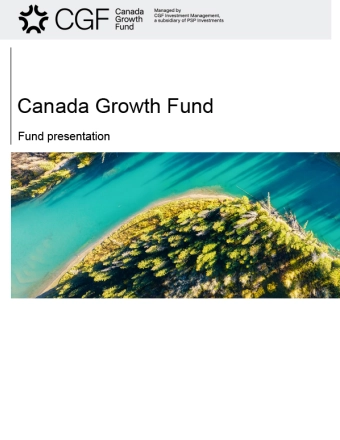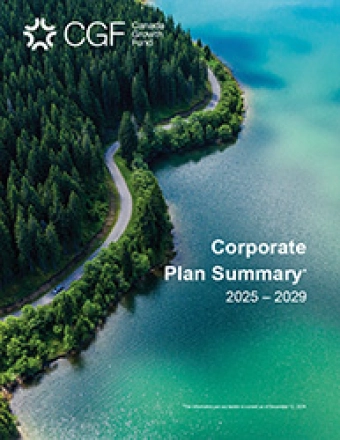Managed by
CGF Investment Management,
a subsidiary of PSP Investments
Our Investment Strategy

Investment Criteria
When evaluating investment opportunities on behalf of Canada Growth Fund (CGF), Canada Growth Fund Investment Management (CGFIM) uses a set of Investment Criteria that supports a rigorous, fair, and consistent evaluation, while evaluating the alignment of opportunities with relevant aspects of the CGF Mandate. Notably, any one individual investment may not fully satisfy all Investment Criteria and Strategic Objectives of the CGF Mandate.
Consistency with goals:
The investment will advance the CGF Mandate and Strategic Objectives.
Long-term benefits for Canada:
The investment has a reasonable chance to strengthen the development of Canadian workers and generate knowledge that will produce long-term benefits for the Canadian economy. For example:
- Canadian presence: activities related to the project or company are done in Canada and/or may generate widely shared economic benefits in Canada.
- Intellectual property: the activity will enable the development, utilization, or commercialization of Canadian IP, or maintain Canadian ownership.
- Value chain creation: the investment will develop or strengthen Canadian competitiveness by participating in a new or existing value chain.
Additionality:
The investment may attract private sector investment, immediately or in the future, that would likely not have been secured without the participation of CGF.
Financial soundness:
The investment will fit within a portfolio that will target preservation of capital.
Consistency with public disclosure sustainability-related principles:
The investment will fit within a portfolio that will assist CGF in meeting internationally recognized standards of sustainability-related measurement, disclosure, and performance.
Investment verticals

Projects
Projects that use technologies and processes, that have been proven in pilots but not yet widely adopted, to efficiently reduce emissions across the Canadian economy, including but not limited to, CCS, electrification and low-carbon electricity, as well as hydrogen and biofuels.

Clean technology
Clean technology companies, including small and medium enterprises, which are scaling less mature but proven technologies that are in the demonstration or commercialization stages of development.

Low-carbon supply chains
Projects, companies, and technologies across low-carbon supply chains, including critical minerals, that will allow Canada to leverage its abundance of natural resources, help secure Canada’s supply chains, and improve Canada’s domestic and global competitiveness.
Driving innovation across key industrial sectors
As per CGF’s Statement of Priorities and Accountabilities, CGF is expected to advance a portfolio aligned with Canada’s economic plan. In particular, CGF is expected to make significant advancement in transactions with a diversity of clean technology sectors, as well as support the decarbonization of heavy emitters.
Financial structures
CGF has the flexibility to employ a variety of investment instruments across the capital structure via equity, debt, hybrid instruments, or by way of Contracts. This allows CGF to provide customized capital solutions to its investments, addressing each of their unique needs and financial profiles. CGF’s investments may be comprised of one or more categories of investment instruments, including:
Equity, debt, and hybrid instruments
CGF may invest in equity (e.g., common shares, preferred shares, trust interests or partnership interests), debt, or hybrid instruments.
Contracts
CGF may enter into contracts and other forms of price assurances to address demand and policy risk and improve project viability. There are three main types of contracts:
- Offtake contracts
CGF may enter into offtake contracts to address demand risk and improve project viability by providing revenue for a volume of production where sufficient demand from prospective private buyers is still developing.
- Contract for difference – Market Price
CfD absorbing carbon credit market risk; if the market price is below the contract strike price, CGF pays the difference to credit holder, and vice-versa.
- Contract for difference – Policy price
CfD absorbing carbon policy risk; if policy price falls below contract strike price, CGF pays the difference to credit holder, and vice-versa
Investment process
Phase 1 (step 2-3)
Initial pre-clearance to ensure alignment with the CGF Mandate
Phase 2 (step 4-5)
Formal assessment against a comprehensive evaluation matrix
- 1
Step 1 : Sourcing
Process Steps:
Dual-track sourcing—active outreach + public email for inbound proposals.
IM+M Integration:
Clear metrics align with investment screening criteria. - 2
Step 2 : Screening
Process Steps:
Pre-clearance memo screens deals via set criteria to align with CGF Mandate.
IM+M Integration:
Memo provides high-level impact check vs CGF Mandate and IM+M goals. - 3
Step 3 : Initial Recommendation
Process Steps:
CGFIM drafts an initial investment recommendation detailing key merits and risks.
IM+M Integration:
Summary table highlights impact factors within the recommendation. - 4
Step 4 : Due Diligence
Process Steps:
CGFIM secures internal approvals, then performs full due diligence per best practices.
IM+M Integration:
Tool assesses impact criteria using insights from all due diligence streams. - 5
Step 5 : Final Recommandation
Process Steps:
After due diligence, CGFIM finalizes the investment structure, prepares a full investment recommendation, and seeks IRIC approval.
IM+M Integration:
The recommendation details all impact metrics and CGF alignment. - 6
Step 6 : Closing & Asset Monitoring
Process Steps:
After final approval, the transaction is funded and closed. CGFIM then monitors the asset post-close per its framework.
IM+M Integration:
Tools track impact performance vs expectations throughout the holding period.

Impact Measurement and Management Approach
CGF’s Mandate and Investment Criteria have been translated into a practical framework built around a standard set of indicators and criteria. The IM+M approach provides structure and consistency to CGFIM's investment process. The Impact Measurement and Management Approach (IM+M) is embedded directly into CGFIM’s investment activities, and all investment team members are responsible for integrating these considerations directly into the underwriting process, and ensuring that impact considerations are harmonized with financial and transaction soundness.

Measuring the outcomes associated with CGF Investments is core to CGFIM's investment and asset management process. To reflect this central importance and ensure that impact and sustainability factors are considered at every stage of the investment process, CGFIM has developed a bespoke framework, approach, and set of tools.
Latest insights













